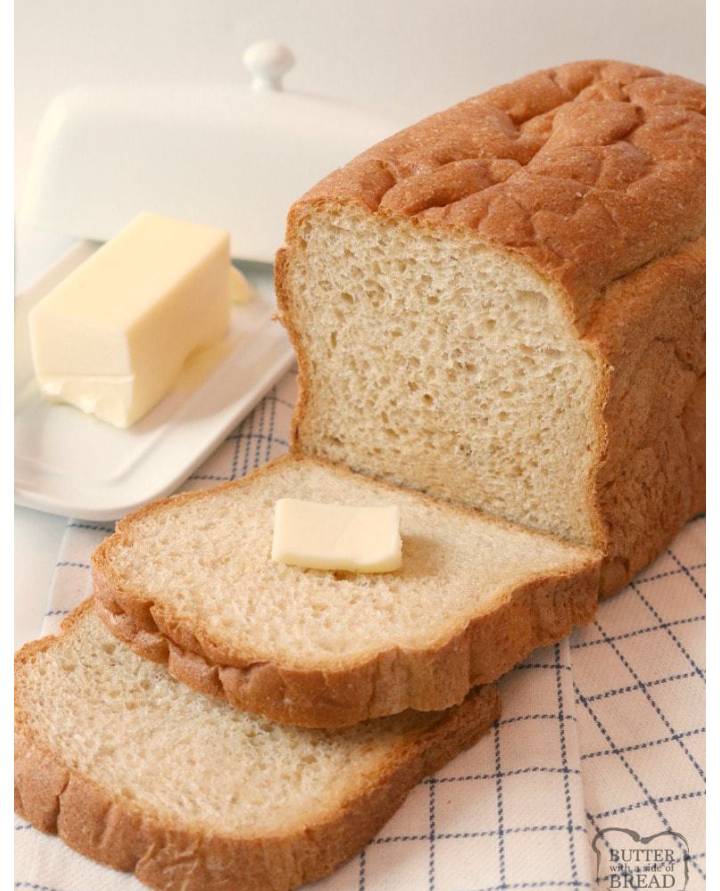TODAY: Get our Favorite Fall Recipes Cookbook Bundle for 60% off
BUY NOWEASY HOMEMADE BREAD RECIPE
PUBLISHED BY JESSICA ON
Easy Bread recipe made with simple ingredients & detailed instructions showing how to make bread! Best homemade bread recipe for both beginners and expert bakers.
If you love Bread as much as we do, find all of our Best Bread Recipes Here!
Homemade Bread is one of my favorite foods of all time. Can you tell by the name of this site?! There really is nothing quite like a warm slice of fresh bread served with a thick pat of butter on top. Mmmmm! This recipe is perfect. It’s simple to follow, takes about 2 hours to make and yields 2 loaves of wonderful bread. It’s quite versatile too, so feel free to use part whole wheat flour if you’d like. Brush butter on top when it’s out of the oven and partially cooled and everyone will thank you.
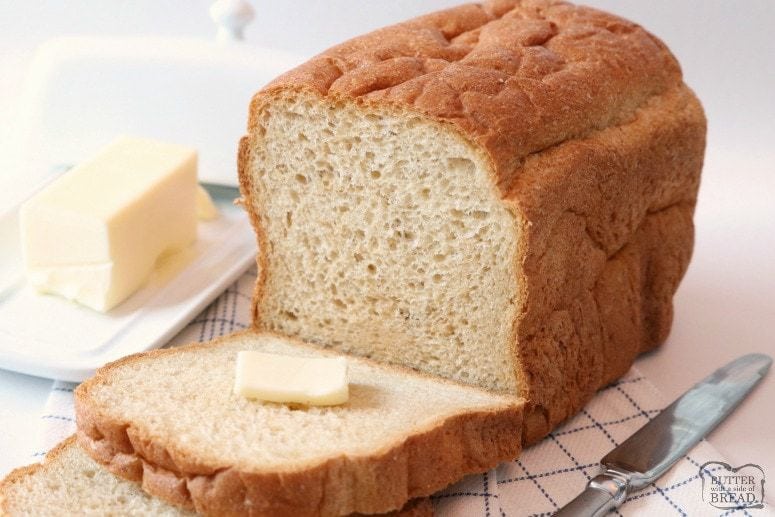
YES, YOU CAN MAKE THIS RECIPE IN A BREAD MACHINE! SCROLL DOWN TO SEE FULL HOMEMADE BREAD RECIPE AND INGREDIENTS, WITH PRINTABLE INSTRUCTIONS FOR YOUR BREAD MACHINE.
I love to cook and I am a pretty confident baker, however, one thing I’ve struggled with is finding a really incredible bread recipe. I know- kind of funny being as there are a zillion out there and bread is one of those ‘basics” that almost anyone can make themselves. Nevertheless, I keep trying new recipes and have finally found one I really like and have gotten good results from! Even better- it’s easy and from start to finish it takes just over 2 hours!
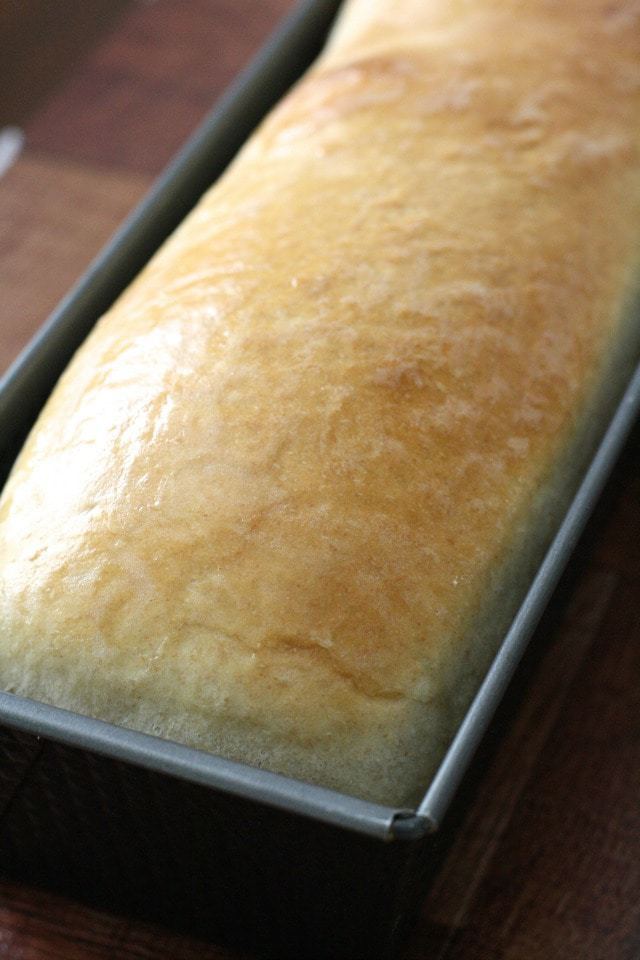
STEPS FOR MOST BREAD RECIPES
If you’ve never made bread before, here is the basic formula for making your own at home. My recipe below follows this perfectly. It’s so much easier and trust me, the scent of fresh bread baking will make everyone really, really excited for dinner!
STEP 1: ASSEMBLE BREAD INGREDIENTS
You’ll need warm water, granulated sugar, instant OR active dry yeast, salt, vegetable or canola oil and flour. That’s it!

STEP 2: DISSOLVE THE YEAST AND ACTIVATE IT BY PROOFING
This is a simple process that takes about 5 minutes. You can see a picture below what yeast looks like when it’s proofed. It’s possible to kill yeast if you use too hot of water, so aim for slightly warmer than luke-warm, or about 105°F. Combine warm water, yeast and 1 TBSP of the granulated sugar in your mixing bowl. Give it a quick stir and then let it sit for 5 minutes. You’ll begin to see the yeast puff up until it covers the entire surface of the water.
STEP 3: ADD REMAINING INGREDIENTS AND MIX
Add the rest of the sugar, the oil, salt and flour (You can use all-purpose flour OR bread flour!), then mix using an electric mixer until it’s well combined, about 2 minutes. You can mix by hand but it will take longer.
STEP 4: KNEAD THE BREAD
You might be thinking, “Wait! It’s already mixed!” Ha! Not so fast! Going through the process of kneading bread dough is crucial for bread with great texture. Kneading dough allows gluten to form which enables dough to rise better, be lighter and fluffier. you can knead by hand or with a mixer. I use the dough hook on my mixer and knead for 7 minutes. If you knead by hand, you’ll want to knead for 10-11 minutes, depending on how consistent you are.

STEP 5: FIRST RISE
Place your lovely smooth, elastic bread dough in an oiled bowl and cover it with plastic wrap or a clean towel. I think plastic wrap works better because it traps hot air inside and thus, my dough requires a shorter first rise. Be sure to spray the side of the plastic wrap that will touch the dough with oil!
If your house is cool, your bread will take longer to rise. In the wintertime when my house is cooler than normal, I like to turn the oven on for 2-3 minutes, then turn it off and let the bowl of dough rise in there. The oven traps the heat for a longtime and it’s the perfect atmosphere for rising dough.
STEP 6: PUNCH DOUGH AND SHAPE IT
Punching the dough down quickly releases any air pockets that have developed and helps your bread have a more consistent rise and texture. Shape your dough by rolling it gently into a ball and rolling it 2 or 3 times on the countertop so that the ball is more oblong. I usually punch down and shape the dough quickly, then place in a greased bread pan.

STEP 7: SECOND RISE
I like to do my second rise in a warm oven that’s not turned on. I turn the oven on just before I punch my dough down, then turn it off once I place the dough in the oven for the 2nd rise. It’s really only on for a minute or two, which is fine! The second rise will help shape your loaf of bread and takes about 30 minutes.
STEP 8: BAKE THE BREAD
You’re nearly there! Bread bakes for about 30-40 minutes. You know what I do to make sure my bread is perfectly cooked? I use a digital cooking thermometer! Fully cooked bread will be 190-200 degrees F. Bread recipes that include milk will need to cook until 200 degrees, but since this one doesn’t, I take it out once it reaches 190 degrees. The top will be golden brown.
My all-time favorite cooking thermometer is the Thermapen. It’s super fast and incredibly durable. Another great thermometer is the ThermoPop which is a more basic version that works just as well!

STEP 9: COOL THE BREAD
Cool baked bread in the pan for 10-15 minutes, then overturn pan and turn loaf out onto a cooling rack or folded towel to finish cooling. If you leave the bread in the pan for much longer than that, you’ll steam it, which may cause some parts of your loaf to go soggy. No one likes soggy bread!
INSTANT OR ACTIVE DRY YEAST FOR MAKING BREAD
If you use instant yeast, you can add it directly to your other dry ingredients when making bread. If you use active dry yeast, you’ll need to first dissolve it in warm water before using it in a recipe. For the sake of ease, I just always buy instant yeast. BUT, this recipe works for both!
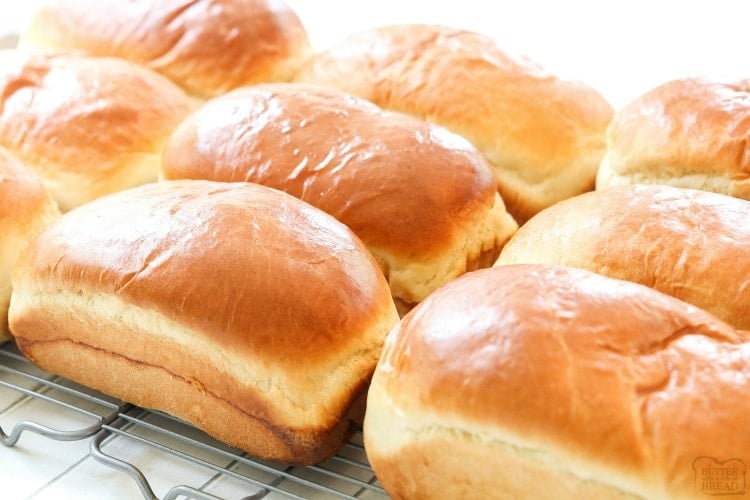
WHICH BREAD PAN IS THE BEST?
I bake a lot of bread and the pans I prefer are either aluminized steel or ceramic. Both types of pans will bake bread more evenly and release the bread more easily after baking. I’ve used glass pans in the past and it seems like my bread sinks too often when using them, so I stopped. I also don’t like using dark or nonstick pans because the bread cooks unevenly. It darkens on the outside before the bread is cooked on the inside, so it’s easier to burn.
HOW TO MAKE BREAD
If you’ve never baked homemade bread before, here are a few tips:
REMEMBER TO FULLY KNEAD
The recipe below kneads for 7 minutes and it’s worth it! Kneading dough helps to develop the flavor and texture of the bread, so don’t skimp on kneading time.
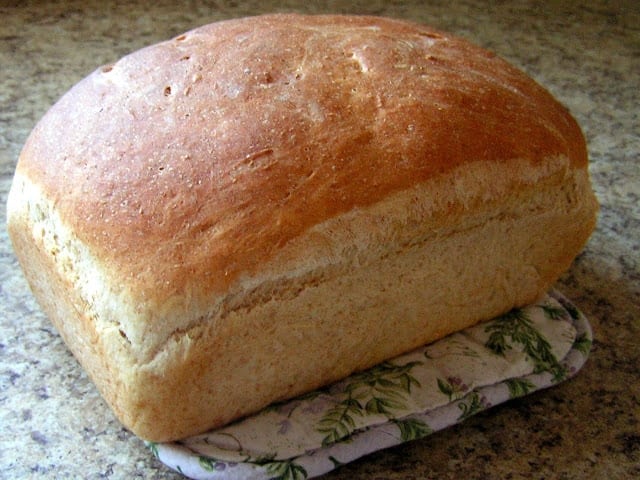
WEATHER CAN AFFECT YOUR INGREDIENTS
If you live in a moist climate, chances are you’ll need at least the recommended amount of flour, maybe even 1/4 cup to 1/2 cup more. Bread dough should be sticky, but still manageable, especially after the first rise. While you’re kneading, the dough should come together and pull away from the sides of the bowl, leaving the bowl mostly clean. I usually aim to have the very bottom of the dough still attached to the bowl. Try not to add too much flour because your bread will be more dense. When you pick the dough up, some will stick to your fingers. After the first rise, it will be easier to handle!
TEMPERATURE AFFECTS HOW LONG YOUR BREAD TAKES TO RISE
If your house is cool, your bread will take longer to rise. In the wintertime when my house is cooler than normal, I like to turn the oven on for 2-3 minutes, then turn it off and let the bowl of dough rise in there. The oven traps the heat for a longtime and it’s the perfect atmosphere for rising dough.
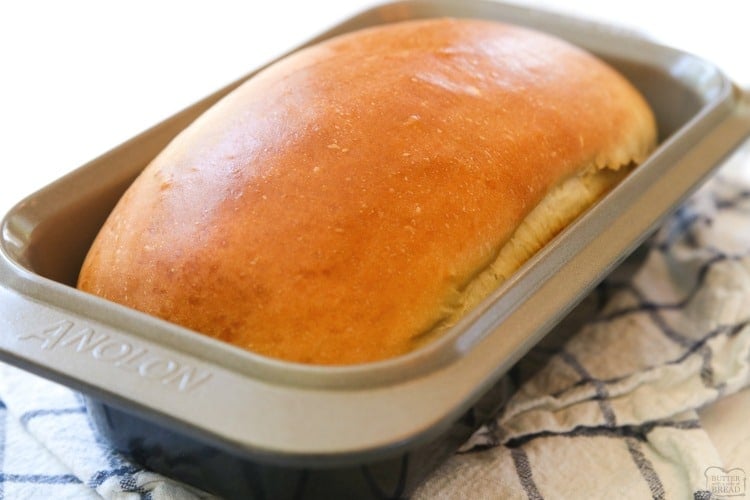
DON’T OVERWORK THE DOUGH
Try not to go crazy kneading your bread after the first rise. I usually knead and shape my dough in about 1 minute, then it’s back in the pan to rest, for the 2nd rise. I like to have the pan rise in the oven for this second rise so that I don’t have to worry about moving risen dough. When it’s fully risen, I just turn the oven on and set the timer to bake!
HOW CAN YOU TELL IF BREAD IS FULLY BAKED?
I like to use a food thermometer. Mine is digital, so it’s very easy to use. Fully cooked bread will be 190-200 degrees F. Bread recipes that include milk will need to cook until 200 degrees, but since this one doesn’t, I take it out once it reaches 190 degrees. The top will be golden brown.
HOW TO STORE HOMEMADE BREAD
You’ll want to store leftover bread in an airtight container. I bought bread bags off Amazon and LOVE them!


